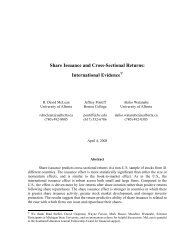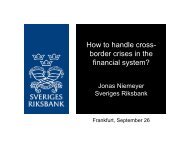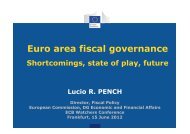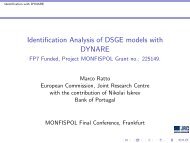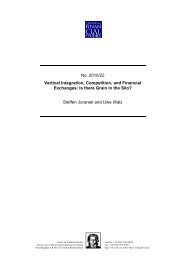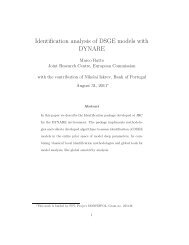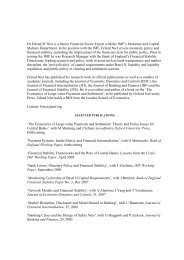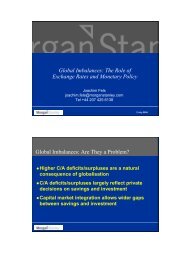Forecasting and Policy Making (Paper) - Center for Financial Studies
Forecasting and Policy Making (Paper) - Center for Financial Studies
Forecasting and Policy Making (Paper) - Center for Financial Studies
Create successful ePaper yourself
Turn your PDF publications into a flip-book with our unique Google optimized e-Paper software.
shows shocks to the potential output growth rate. A series of highly negative shocks led to the current<br />
extremely low estimates of potential output growth. Given the high variance of this shock series po-<br />
tential output could quickly adjust back to higher equilibrium growth rates once actual output growth<br />
increases.<br />
5.4 <strong>Forecasting</strong> with medium-scale New-Keynesian DSGE models<br />
In recent years many policy institution have built medium-size dynamic stochastic general equilib-<br />
rium (DSGE) models that offer much more detailed structural interpretations of the data as the small<br />
model of the preceding section. More <strong>and</strong> more of these DSGE models are also used as a tool in the<br />
<strong>for</strong>ecasting process. For example, the European Central Bank has replaced its earlier, more traditional<br />
Area-Wide Model of Fagan et al. (2005) which featured largely backward-looking dynamics, with<br />
a New-Area-Wide Model (see Christoffel et al. (2008)) of the DSGE variety in the ECB staff <strong>for</strong>ecasting<br />
process. 31 The Federal Reserve makes use of the FRB/EDO model of Edge et al. (2008), 32<br />
though the FRB-US model still remains its principal model <strong>for</strong> policy analysis. DSGE models used<br />
at other central banks include the ToTEM model of the Bank of Can<strong>and</strong>a (Murchison <strong>and</strong> Rennison,<br />
2006; Fenton <strong>and</strong> Murchison, 2006) <strong>and</strong> the Ramses model used at the Swedish Riksbank (Adolfson<br />
et al., 2007b, 2008). All these models build on the medium-size DSGE model of Christiano et al.<br />
(2005). Christiano et al extended the simple New-Keynesian DSGE model <strong>and</strong> showed that such a<br />
medium-size DSGE model can match the VAR-based estimate of a monetary impulse response func-<br />
tion. Typically, these models are estimated instead with Bayesian estimation methods as proposed <strong>and</strong><br />
exemplified by Smets <strong>and</strong> Wouters (2003, 2007). In this manner they are able to explain the dynamics<br />
of a large number of macroeconomic times series.<br />
In the following, we will produce <strong>and</strong> interpret <strong>for</strong>ecasts using such a medium-scale DSGE model<br />
estimated in Cogan et al. (2010). Cogan et al. extended the Smets <strong>and</strong> Wouters (2007) model of the<br />
U.S. economy by introducing a share of households that consume current income. Such an extension<br />
was proposed by Gali <strong>and</strong> Lopez-Salido (2007) in the context of a small New Keynesian model in<br />
order to underst<strong>and</strong> the consequences of fiscal shocks. Cogan et al. (2010) use this model to analyze<br />
the interaction of monetary policy <strong>and</strong> the U.S. ARRA fiscal stimulus at interest rates near the zero-<br />
lower bound. In the following, we refer to this model as the CCTW-SW model.<br />
An appealing feature of DSGE models is that they implement all restrictions arising from<br />
optimizing behavior of households <strong>and</strong> firms subject to clearly specified constraints. Thereby they<br />
go far in the Lucas critique <strong>and</strong> offer a useful input <strong>for</strong> monetary policy making. DSGE models are<br />
31 In addition, the model of Christiano et al. (2008), which includes a more detailed financial sector also plays an important<br />
role. The use of both models at the ECB is described in Smets et al. (2010)<br />
32 The FRB-EDO features two production sectors, which differ with respect to the pace of technological progress. This<br />
structure can capture the different growth rates <strong>and</strong> relative prices observed in the data. Accordingly, the expenditure side is<br />
disaggregated as well. It is divided into business investment <strong>and</strong> three categories of household expenditure: consumption of<br />
non-durables <strong>and</strong> services, investment in durable goods <strong>and</strong> residential investment. The model is able to capture different<br />
cyclical properties in these four expenditure categories. The model is estimated using Bayesian techniques on eleven time<br />
series.<br />
46



